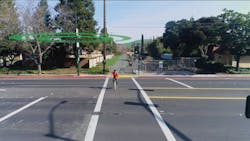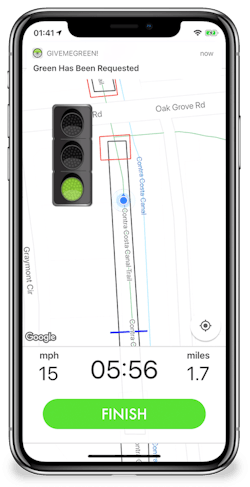Technology trends to increase pedestrian and cyclist safety
City streets are evidently dangerous for pedestrians, bicyclists, and other vulnerable road users (VRUs).
For example, 30 people are killed and more than 500 others are seriously injured annually in traffic-related accidents in San Francisco alone, a city with less than 1 million people. A disproportionate number of these fatalities and serious injuries happen to pedestrians and bicyclists. Between 2016 and 2019, there were 75 fatalities in vehicle-to-pedestrian accidents and 12 in vehicle-to-bicycle accidents according to San Francisco’s TransBASE Dashboard. About 75% of these fatalities occurred at intersections.
San Francisco is far from being the only city with a major traffic safety problem, nor is it one of the worst in this category. Like many other cities, starting in 2014, San Francisco committed to an ambitious Vision Zero program with the goal of dramatically reducing these numbers. It is a data-driven program that focuses on actions most likely to improve safety at locations with more frequent accidents and injuries.
Unsurprisingly, improving intersection safety for pedestrians and bicyclists is a central goal of the San Francisco program, and of most Vision Zero programs. This approach continues to attract significant investments in new products and technologies that can make intersections safer for peds and bicyclists. Here is a look at some of the more recent developments aiming to improve safety for VRUs.
Improvements in detection for bikes and peds
Traffic management systems rely heavily on accurate detection to optimize the operation and efficiency of traffic signals. Historically, the focus has been on maximizing the flow of vehicles with limited attention paid to bicycles and pedestrians. Consequently, detection solutions were designed to accurately detect and classify vehicles, and complaints from bicyclists that they are not detected at the intersection (often inductive loops) have been a common theme around the world.
Fortunately, there have been significant advances in sensing technologies and data analytics to improve bike and ped detection. For agencies that prefer above-ground detection solutions, thermal cameras that use body heat to detect bikes and peds offer improved accuracy. HD video and advances in image processing have also improved the performance of standard video detection of bikes. And new radar solutions have been successfully deployed to detect the presence of pedestrians in the crosswalk.
For agencies that prefer in-pavement solutions, wireless micro-radar sensors offer vastly improved detection accuracy for bikes at the stop-bar compared to loops, and they are much more durable and cost effective. Wireless micro-radar has also been successfully used to detect pedestrians in the crosswalk.
With these recent advances, detection performance has improved significantly for some applications such as detecting bicycles at the stop-bar or pedestrians in the crosswalk; yet much work remains to accurately discriminate between bikes and vehicles in mixed traffic lanes or estimate the number of pedestrians on the curb waiting to cross. For these more complex challenges, machine learning holds significant promise.
Performance improvements with machine learning
Conventional video analytics cannot deliver accurate enough data, but new developments in artificial intelligence, and particularly deep learning, can. Deep learning technology contributes along two lines: it helps enhance the accuracy of video analytics, and can better differentiate between the different road users. A solution using deep learning is trained on what a pedestrian looks like in a city environment so it will more accurately identify peds and tell them apart from other road users, shadows, and reflections.
While the principles of artificial intelligence are not new, the recent development of deep learning technology is made possible by the availability of graphical processing units (GPUs) that can efficiently run deep learning based analytics in real-time. Initially deployed on servers, this technology is now available directly inside video cameras, offering a cost-effective edge solution that can easily be adapted to the IT infrastructure of each city. Better cameras with enhanced nighttime visibility and higher resolution have also been key to enhancing the accuracy of video analytics solutions.
However, there can still be gaps between expectations of cities and what deep learning-based video analytics can provide. Depending on the environment, telling a bicycle apart from a motorcycle or a scooter can still be a big challenge. Yet it is just a matter of time for deep learning to overcome these challenges.
I2V communications can make intersections safer
In a recently published paper, researchers at the University of California at Berkeley analyzed what makes intersections so dangerous. They determined that several of the most important factors can become less dangerous if the driver or autonomous vehicle is given additional information about the signal phase and timing (SPaT) along with data from strategically based detectors through infrastructure-to-vehicle (I2V) communications.
The path of vehicles, bicycles, and pedestrians cross each other within intersections creating “conflict zones” that are sometimes obstructed from view by other vehicles or objects. These conflict zones can be entirely mapped for a given intersection, and the right detection technology can determine if they are occupied at any given time and communicate this in real time to road users.
Also, drivers, pedestrians, or a bicyclist use the signal lights to know whether their planned movement is permitted, but they may not know if a potentially conflicting movement is also permitted at the same time. This spatial uncertainty about right-of-way can be eliminated if the infrastructure provides complete phase information as part of a SPaT I2V message.
Lastly, even when there is no conflicting movement, a crash may occur from the illegal movement of other vehicles or road users. With appropriate feedback from the sensors, the road user can be warned and take evasive actions.
Smartphone apps open the door to virtual pedestrian and bicycle detection
These days practically all pedestrians and bicyclists have a smartphone with GPS positioning. So the secure exchange of data between traffic signals and smartphone apps is opening the door to a host of new mobility and safety solutions for VRUs. Siemens SiBike, Dynniq CrossCycle, and Sensys Networks GiveMeGreen! smartphone apps are examples of such solutions that are transforming the way bicyclists and pedestrians are being detected and are interacting with traffic signal controllers.
While they differ in the ways they are implemented, the concept of operation for each of these solutions is quite similar. Here’s an example use case:
- The phone’s GPS positioning is used to locate bicyclists approaching equipped traffic signals
- When the bicyclist crosses a ‘virtual tripwire,’ the app alerts the traffic signal controller of the approaching bicyclist and its expected arrival time at the intersection so it can inform the bicyclist that they have been detected
- The controller then extends the current green phase or activates the designated signal timing plan that properly serves these road users
Solutions like these for bicyclists improve mobility by reducing the number and duration of stops at signals, but even more importantly increase safety by improving detection accuracy for bikes and informing bicyclists that they have been detected. This reduces instances of bicyclists proceeding through a red light, which happens when they do not feel that they are being detected.
App-based solutions have been deployed in several cities in the U.S. including Santa Clarita, California where the project won numerous industry awards. In that city, the solution is deployed on bike lanes that intersect heavily traveled arterials and triggers a lighted sign to alert turning motorists of bicyclists about to cross.
Similarly, these virtual detection solutions can offer significant benefits to pedestrians, particularly visually impaired, elderly, or handicapped road users by communicating the special needs to the signal controller that may enable, for example, a longer pedestrian crossing phase. For the visually impaired, crossing a large intersection can be very challenging and dangerous, starting with simply finding the ped crossing button. Smartphone apps can place the crossing request wirelessly, and also provide additional audible information to the user about the number of lanes, geometry, and other valuable information to assist with a safer crossing.
In conclusion
As described above, detection for VRUs, including discerning between modes of travel, has improved dramatically in recent years. Additionally, I2V communications and smartphone apps can fill critical information gaps, especially when the environment is obstructed or the users are visually impaired. It is safe to say these solutions lend hope, and real solutions to Vision Zero programs around the world.


